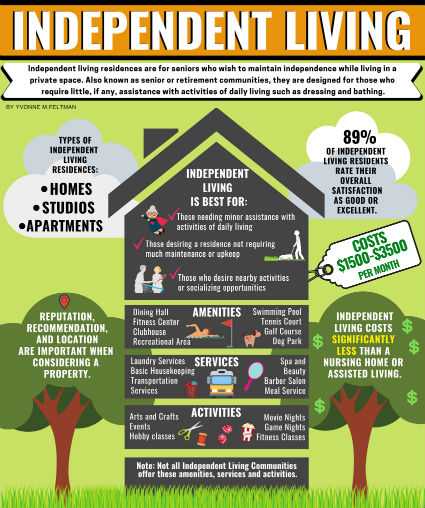About Independent Living

Independent living can be a great choice for seniors who can still manage themselves on a day-to-day basis, but who are looking to downsize or to have certain services close at hand, such as medical services. Typical independent living communities can vary broadly, but usually provide seniors with their own accommodation. Apartments, townhouses, and condos are all available as examples of independent living accommodations. Among of the biggest benefits of independent living communities, also sometimes called retirement communities, are the social benefits they offer seniors.
Top Cities for Independent Living in the US
- Miami, FL
- Houston, TX
- Chicago, IL
- San Antonio, TX
- Seattle, WA
- Portland, OR
- Indianapolis, IN
- Dallas, TX
- Philadelphia, PA
- Los Angeles, CA
- Cincinnati, OH
- San Jose, CA
- Denver, CO
- St Louis, MO
- Spokane, WA
- Pittsburgh, PA
- Minneapolis, MN
- Phoenix, AZ
- Louisville, KY
- Las Vegas, NV
- San Diego, CA
- Austin, TX
- Sarasota, FL
- Tucson, AZ
- Grand Rapids, MI
- Sacramento, CA
- Colorado Springs, CO
- Albuquerque, NM
- Tampa, FL
- Milwaukee, WI
More About Independent Living
Independent living can be a great choice for seniors who can still manage on a day-to-day basis but are looking to downsize or to have certain services close at hand, such as housekeeping and shopping. There are many kinds of independent living from apartments to small homes to co-housing.
What is Independent Living?
Independent living, often referred to as a retirement community, is intended for seniors who wish to remain independent while living in a private space. Seniors may pay for some congregate services such as meals or housekeeping as part of the monthly fee or rental rate, but this is optional. These individuals require little, if any, assistance with activities of daily living such as dressing and meal preparation. Residents of independent living units may have some home health care-type services provided to them by staff or an outside agency. Typically, there is staff onsite as well as building security.
Independent living encompasses a wide range of housing arrangements, from apartment-style communities to housing co-ops. Generally, residents live in their own private living spaces and have access to common areas where they can gather with other members of the community. Because this option is designed for seniors who can still live independently, the features and amenities in the individual dwelling areas are comparable to those in a typical apartment complex or planned community.
What Services Are Included in Independent Living
Every community is quite different, and the levels of services will affect the monthly cost and initial fees significantly. Here are some examples of amenities that may be offered:
- Hair salon & barber shop
- Concierge services
- Transportation
- Game/TV room
- Golf course
- Healthcare center
- Private rental hall
- Laundry service
- Restaurant-style dining hall
- Fitness center
- Swimming pool
- Sports and exercise programs
- Computer labs
- Gardens and walk/biking paths
- Organized travel/day trips
- Day spas
In addition, some seniors who live in Independent Living hire in-home care. In-home care options such as daily nurse and medical services. These are either charged by an external home care agency or provided by the Independent Living community.
When to Consider Independent Living
Although there are many factors to consider, here our four key areas to think about as you're evaluating whether to move to independent living versus other options.
- Transportation - Do you plan to continue driving? What are the options in your area if you need to stop driving at some point?
- Finances - Do you have the income to cover your needs, including in-home care, if it becomes necessary?
- Health care - Do you live near the doctors and a hospital? How could you handle a medical problem on the weekend or on a holiday?
- Household maintenance - Which tasks can you still handle, and which do you need help with? Who is available - volunteer or professional - to help?
Senior Apartments
Senior apartments might be referred to numerous ways: 55+ apartments, 62+ apartments, age-restricted apartments, or active adult apartments. Benefits of senior apartments include planned activities such as exercise classes, movie nights, card game parties, and local day-trips. They also typically have extra security measures such as cameras and emergency alert systems. Some also have security-patrolled grounds and even security guards posted at entryways. The biggest difference from senior communities is that they generally do not include meals and housekeeping as part of your rent.
55+ Communities
Age-restricted communities let seniors buy or rent housing on properties with shared amenities and services such as golf courses, swimming pools and transportation. Each residence is typically connected to the others by sidewalks or other paths. Residents of age-restricted communities have many opportunities to socialize informally and through planned activities. Generally, a clubhouse serves as the community center with areas for restaurant-style dining and recreational activities.
According to an American Housing Survey conducted in 2011, it is projected that there will be an increase in demand for housing in 55+ communities going forward, as the share of households age 55+ is expected to grow annually, and to account for nearly 45% of all U.S. households by the year 2020. Home purchase prices in age-restricted communities vary with local housing markets.
Senior Co-housing
Cohousing.org, run by the Cohousing Association of the United States, defines cohousing as "an intentional community of private homes clustered around a shared space." In a cohousing community, residents live privately in condos or attached homes, but share certain properties or amenities with other residents. The main idea behind cohousing (and the biggest advantage) is that it balances privacy with a community atmosphere. Through the sharing of food, energy, maintenance upkeep costs, and other expenses, residents of cohousing communities can save hundreds or even thousands of dollars over what they would pay for comparable senior living arrangements elsewhere.
Independent Living vs. Assisted Living
Independent living services are aimed at minimizing seniors' daily responsibilities, not assisting with activities of daily living, which is the focus of assisted living. Landscaping, laundry and housekeeping services, on-site dining facilities, security surveillance, and a variety of activities and events are typical. Assisted living, on the other hand, provides help with daily living activities such as bathing, dressing, grooming and other personal care. Often, independent and assisted living facilities are co-located, so that seniors can shift to assisted living when their needs increase over time.
Independent Living vs. Home Care
Preference, abilities and cost are determining factors when choosing between independent living and home care. If the weight of managing a household is becoming too much for a senior, independent living might be the answer. It's typically a smaller, more manageable apartment and home care services can be provided in their new space. However, for seniors who are very attached to their living environment and have the funds to hire home care for housekeeping, yard work and repairs, this may be a better option.
Independent Living vs. CCRCs
Continuing Care Retirement Communities (CCRCs) offer a combination of independent living apartments, assisted living units and skilled nursing care rooms all available on one campus. Unlike an independent living community which typically offers no daily living assistance services or skilled nursing, CCRC residents can transition to other areas within the community that will serve their increasing care needs. The demand for CCRCs continues to grow as the number of people reaching retirement age rises. CCRCs have evolved over the past several years and offer enticing service packages and entrance-fee options. Providing 24-hour staff and security, gourmet meals, religious, social and leisure activities, housekeeping, laundry, transportation, wellness and fitness programs, CCRCs are an attractive all-inclusive housing option for seniors.
CCRCs are governed by state regulations in most states, and typically are classified as an insurance model and governed by the state department of insurance. Each of the components making up a CCRC are subject to separate regulations - the housing units may be regulated at the local level, the assisted living regulated by the state, and the nursing home portion of the community is governed by state and federal regulations.
How Much Does Independent Living Cost?
Independent living costs significantly less than a CCRC, a nursing home, or even assisted living. The monthly fees for independent living vary mainly due to size and location, with the average cost ranging from $1,500 to $3,500 per month. Some communities require an entrance fee, also called a "buy-in" fee, while others only require monthly rent. Like any long-term-care option, independent living costs and options vary by area - it is important to explore each facility, ask questions and read over agreements carefully to be sure the community offers what is desired.
Rent and utilities represent the primary cost for independent living residents. Aging adults who live in communities that offer specialized recreational opportunities like private golf courses may incur additional expenses in the form of membership and/or joining fees. Different meal plans are usually available for on-site dining, and additional costs may be involved depending on the mix of services and add-ons chosen.
How Can I Pay for Independent Living?
Since independent living communities don't provide residents with medical services, Medicare, Medicaid, and other financial aid programs won't cover the cost. Instead, seniors must pay privately, using funds from Social Security benefits, pension income, retirement savings, life settlements, reverse mortgage funds, annuities and other personal funds.
Social Security and Pensions
Seniors receiving Social Security and other types of pensions can use those funds cover retirement-related living expenses, including payments made to reside in an independent living community. This contrasts with Medicare and Medicaid, which are more geared towards the payment of an elder's health care costs, or a low-income senior's medical and housing expenses, respectively.
Government Programs
The U.S. Department of Housing and Urban Development (HUD) offers help paying for both independent and assisted living to eligible low-income seniors through the Housing Choice Voucher (formerly Section 8) and Section 202 programs. However, due to high demand for these programs, the waiting lists are often very long.
Long-Term Care Insurance
Benefits vary from policy to policy, but some forms of long-term care insurance will cover independent living costs. Before signing up for a policy, make sure you clearly understand what it will and won't pay for, including which senior housing categories (e.g. assisted living, in-home care, skilled nursing) are and are not included.
Life Insurance
These options greatly depend on the type of life insurance policy so it's best to discuss with an insurance broker or financial advisor.
- Life Settlement - You can sell your life insurance policy to a third party for market value and use the proceeds to fund independent living.
- Surrender Policy - You give up ownership and the death benefit. If the policy has accumulated cash, the insurance company writes you a check for the full amount of cash value, which is often taxed.
- Policy Loan - You can take a loan from your life insurance policy, which means you won't pay taxes. However, you can't take it all or the policy will lapse.
- 1035 transaction - This allows you to exchange cash value from an existing life insurance policy into a new life insurance policy with long-term care insurance benefits tax-free.
Reverse Mortgage Loans
The Home Equity Conversion Mortgage (HECM) is a reverse mortgage that seniors take against their home's equity. Insured by the federal government, it is only accessible via lenders approved by the Federal Housing Administration (FHA). Once finalized, the lender makes payments in a single lump sum, monthly installments, or as a line of credit. The loan does not have to be paid back until the last borrower passes away or moves from the home for one full year. The home is usually sold, and the lender is paid back the full loan amount plus interest
Private Funding
In situations when costs aren't covered through other means, paying via private funds is an option. Sources of private funds for assisted living include retirement accounts and 401Ks, savings accounts, annuities and insurance plans (including life settlements), trusts and stock market investments. Home equity and bridge loans can also be used when transitioning to an independent living community.
Evaluating Independent Living Communities
When considering independent living communities, you would evaluate its pros and cons like any apartment complex or condo. What amenities are more important to you? Does the property appear well managed and clean? Here are some factors to check off your list.
Location
- Community is conveniently located for family and friends
- Neighborhood is safe
- Shopping and entertainment are nearby
- Medical facilities are nearby
Hospitality
- Visitors are greeted warmly
- Staff members offer courteous greetings
- Staff members address residents by name and show respectful familiarity
- Residents are friendly and welcoming
- You feel safe, unpressured and comfortable
- All your questions are answered
Dining
- Dining venues look inviting
- Dining room is clean and in good condition
- Residents can invite guests for meals
- Residents can provide input on menu
- Community accommodates special diets
- Dietician or nutritionist is involved in meal planning
- Multiple dining venues
- Sample several meals
Wellness & Enrichment
- Calendar of activities and programs that appeal to you
- List of resident clubs, groups and committees
- Many fitness programs and classes
- Classes, lectures and other learning opportunities are offered
- Volunteer opportunities available inside and outside the community
- Spiritual support or religious services are offered
- Entertainment and cultural events are organized
Support Services
- Access to non-medical home care
- Housekeeping, maintenance and laundry are provided
- Transportation available
- Security 24/7
- Nurse station or wellness clinic
- Pricing Structure
- Property Maintenance
Property & Maintenance
- Community clean and well maintained
- Ample parking is provided for residents and visitors
- Parking area is convenient and well lit
- Safety features in place such as handrails and grab bars
- Residences have safety features, emergency alert and fire suppression
- Residents can decorate living spaces
- Community is pet-friendly
Pricing Structure
- Base cost and what's included is clear
- List of add-on services and their cost is available
- Meal plan explained
- Entrance fee and refund policy is reasonable
- Pricing sheets for floor plans, contract types and care services are provided
- Explanation of annual rate increases
Independent Living Regulations
Since independent living communities do not provide healthcare services, they are not subject to the same rules and regulations governing long-term care facility operations. However, many of these communities do serve food, so they are likely inspected by local health departments. They would also be inspected for compliance for fire code compliance. Asking to review these records can tell you whether the community follows required state and federal regulations.
Additional Independent Living Resources
- What Is Senior Co-Housing?
- What is Independent Living for Seniors?
- Independent Living or Assisted Living? What is the Difference?
- Paying for Independent Living
Top Articles in Independent Living
View All
What is Independent Living?
Among the different options available for senior housing, independent living is the least hands-on and the least expensive. While seniors who are still living in their own homes could technically be described as "living independently," in senior housing, "independent living" just describes senior...More
Read More
Independent Living or Assisted Living? What is the Difference?
In today's senior living community, there are a number of housing options available that can provide seniors with the ideal environment to enjoy their golden years. Every senior is unique, just as every situation is unique, which means that different seniors may benefit from different types of care ...More
Read More
What Is Senior Co-Housing?
If you've been researching senior living arrangements, either for yourself or a loved one, then chances are you're already thinking about the standard options – home care, retirement communities, or independent living. If you dig a bit deeper, you might find that another living option is becoming ...More
Read More

 Your Information is Processing
Your Information is Processing